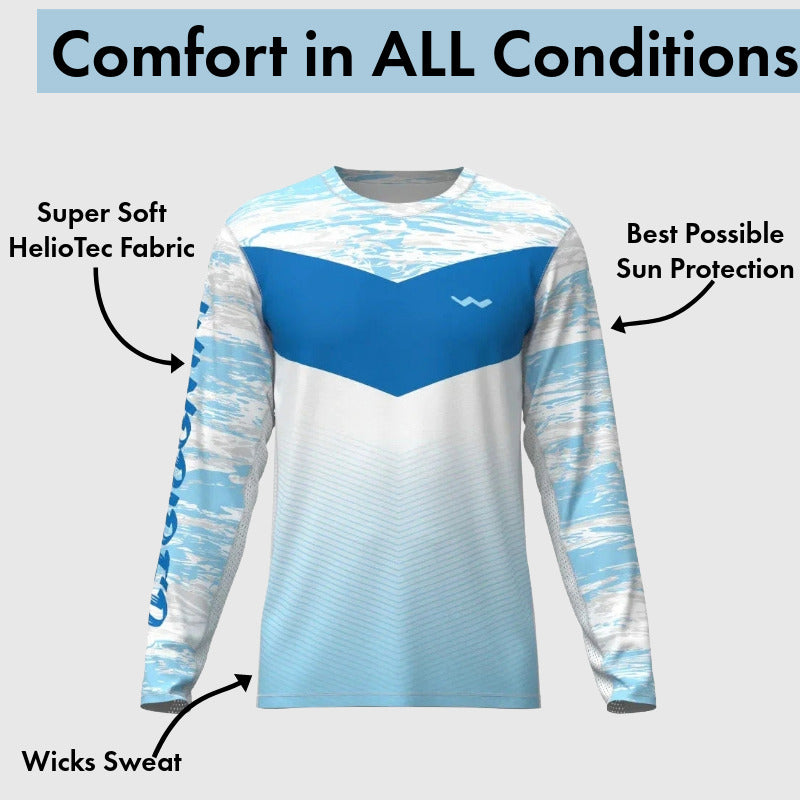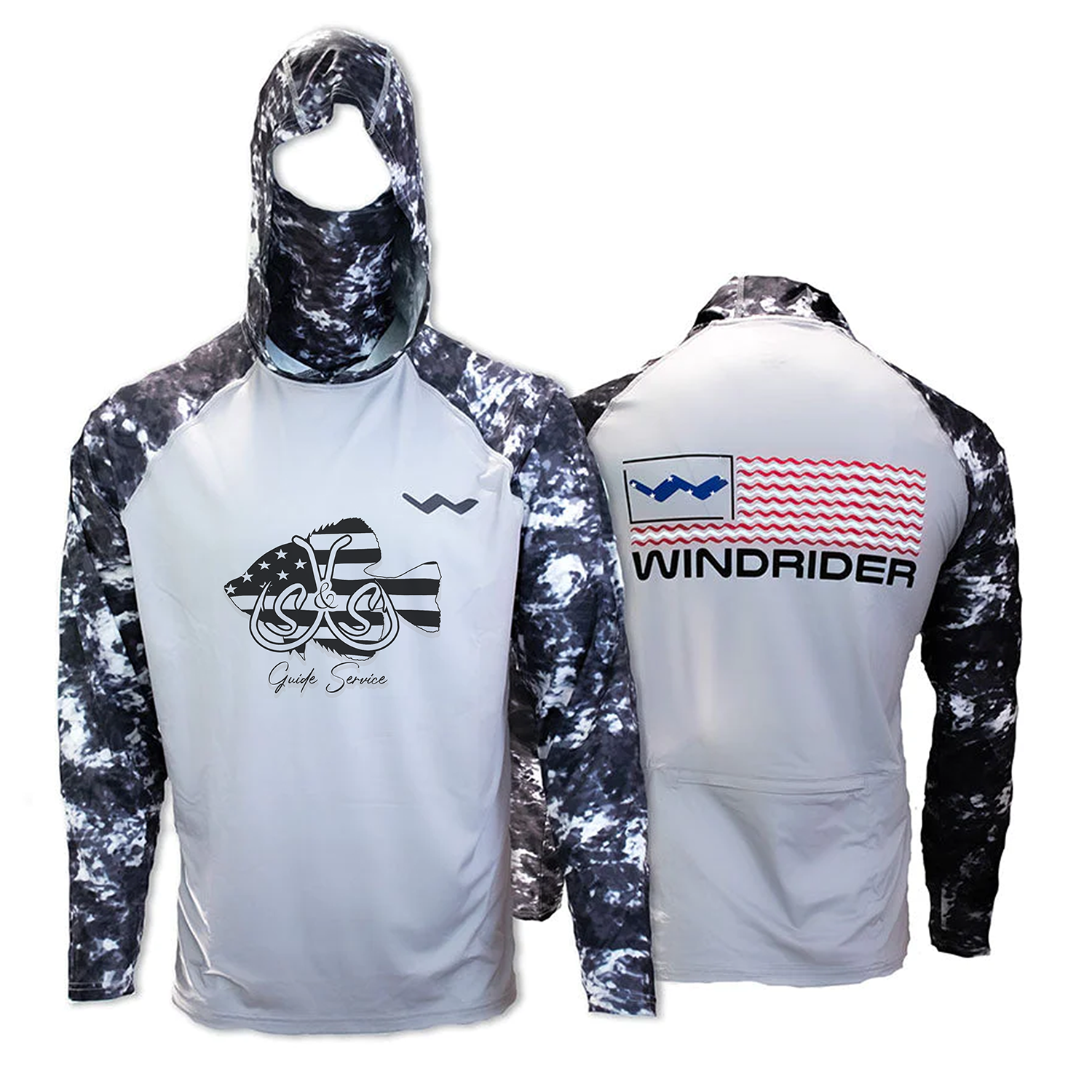Understanding the Sleeve Migration Problem
Every angler who's worn long-sleeve shirt while on water knows irritation of sleeve migration. You start morning with coverage, sleeves reaching all way to wrists. Yet after about 30 minutes of active fishing, those sleeves begin creeping up forearms, exposing 3-5 inch strip of skin to full sun for rest of day.
Migration unfolds as inevitable byproduct of casting mechanics. Whenever overhead cast is made, arms are thrust upward and outward. Because sleeve is unbound, gravity and motion's momentum cause fabric to slip toward elbow. After day's worth of hundreds of casts, repeated motion incrementally pushes sleeves higher up arms.
Pulling in fish, handling tackle, and any general arm movement all aggravate issue. Whenever elbow bends or arm extends, sleeve can shift, leaving wrists and lower forearms bare and exposed to 6-10 hours of UV radiation.
Particular way sun strikes those areas produces telltale "fisherman's tan"—hands and wrists deeply colored or even burned, stark contrast to lighter forearms and upper arms that stay shielded beneath shirt. Yet it's not merely cosmetic quirk; that same band of skin ages faster and carries markedly higher risk of skin cancer, consequence of relentless accumulation of UV damage.
How Thumb Holes Prevent Sleeve Migration

Thumb holes act as mechanical anchor that utterly eliminates sleeve migration. By slipping your thumb through opening, you physically tether sleeve to your hand, so it simply cannot climb up your arm—your thumb locks it in place.
This anchor system operates passively—once you've slipped shirt on, no deliberate maintenance is needed. Whether you're on your first cast or 400th, sleeve stays exactly where it should with zero adjustments. Mental burden of pulling sleeves back down simply disappears.
In fishing shirts, thumb-hole opening—like those featured in Helios collection—is engineered with suite of deliberate design features:
- Strategic placement: Hole sits approximately 2-3 inches from sleeve cuff, positioning fabric securely across back of hand while leaving palm and fingers completely free for tackle handling and line management
- Reinforced opening: Thumb hole edges receive reinforced stitching to prevent tearing or expansion during use
- Elastic recovery: Fabric around thumb hole maintains elastic properties, gripping thumb gently without creating uncomfortable pressure or restricting circulation
- Optional use: You're never forced to use thumb holes. On cooler days when you want maximum ventilation, simply leave thumbs out and sleeves function as standard cuffs
Hand Sun Protection: The Overlooked Critical Area

While anglers generally remember to protect face, neck, and arms, hands often receive inadequate attention despite being among most sun-exposed areas on body.
Think about hand positioning during fishing. Your hands remain constantly visible, positioned in front of body while casting, retrieving, handling fish, and working tackle. They face upward toward sky during many fishing activities. Backs of your hands receive nearly continuous sun exposure throughout fishing days.
Dermatological investigations reveal that hands accumulate some of highest total UV doses across body—only face tops list. Skin on backs of hands is relatively thin and lacks oil glands that afford other areas modest natural protection. Consequently hands are especially vulnerable to sun-induced damage, premature aging, and development of skin cancer.
The UPF 50+ fabric extending across backs of hands through thumb hole designs blocks 98% of UV radiation, providing far superior protection than any reasonably applied sunscreen.
Why Sunscreen Fails for Hand Protection
Many anglers assume that quick coat of sunscreen on hands will do job, yet in reality hand-applied sunscreen constantly falls short because of demands of fishing.
Contact with water: Fishing keeps hands in water more than you might think: hauling lines, feeling fish, dipping into livewells, or just getting drenched by splash. Each contact strips away bit of sunscreen. After 6-8 such contacts, bulk of protection is gone, no matter what "water-resistant" label promises.
Friction and handling: Fishing keeps hands in motion: gripping rod, tying knots, fiddling with tackle, and host of other chores. That rubbing and abrasion acts like eraser, stripping sunscreen right off. Tiny latches on tackle box, rod's grip, and fishing line itself serve as little scrubbers, whisking protection away as you fish.
Browse our browse our rain gear for more options.
Sweat: On hot fishing day, palms can get drenched with sweat. That moisture not only feels clammy, it also thins sunscreen layer and washes it off, so protection fades far earlier than usual reapplication interval.
Greasy hands problem: Sunscreen on hands creates slippery surfaces that make fishing tasks difficult. Line management, knot tying, and fish handling all become more challenging with greasy, sunscreen-coated hands. Many anglers unconsciously wipe sunscreen off hands to improve grip, eliminating protection entirely.
When you stack those factors together, sunscreen on hands ends up basically useless for fishing. Even though reapplying every 30-45 minutes would keep protection alive, most anglers don't remember—or don't want—to stick to that schedule. Consequently their hands stay fully exposed to sun for entire day on water.
Fishing shirt with thumb holes quietly solves problem, providing lasting protection that never needs attention and stays out of way when handling tackle or managing line.
Beyond Casting: All-Day Activity Considerations
Casting represents only one component of activities that cause sleeve migration during fishing days.
Fish fighting: Playing strong fish involves extended arm motions, rod pumping, and reel cranking that all shift sleeve position. Single hard-fighting fish can push sleeves up 2-3 inches through exertion and range of motion involved.
Boat operations: Pulling anchor, working dock lines, deploying or retrieving trolling motor, and general boat handling all involve arm movements that shift clothing. For boat captains and guides, these operations occur dozens of times daily.
Wade fishing: Walking through water while fishing creates situations where you use arms for balance and navigation through current or uneven bottom. These movements constantly affect sleeve position in ways you don't consciously notice until you look down and see exposed forearms.
General fishing tasks: Opening tackle boxes, reaching for gear, fine-tuning rod holders, hauling in fish, and endless parade of everyday motions each chip away, causing subtle cumulative sleeve migration that stacks up over marathon of fishing hours.
Thumb holes keep protection where it belongs no matter what you're doing, so you never have to fuss with sleeve's position. Real value is that it works passively and automatically.
Winter and Cool Weather Benefits
Thumb holes provide unexpected benefits beyond sun protection during cool weather fishing.
During months of spring and autumn when air usually lingers between 50°F and 65°F, thumb-hole constructions slip in touch of extra warmth, sparing fisherman clumsiness of full glove. At same time, thin veil of fabric spanning backs of hands works as wind shield, offers modest insulating layer, and still keeps palms and fingers unrestricted for handling tackle.
This proves particularly valuable during dawn fishing sessions when temperatures start cool but warm up by mid-morning. With thumb holes engaged, your hands stay comfortable during chilly launch and early fishing. As temperatures rise, you can disengage thumb holes for maximum ventilation without changing garments.
From cool mornings to sun-soaked afternoons, shirt's flexibility means single garment can cover entire temperature gamut of fishing season, letting clutter of specialty apparel be set aside.

